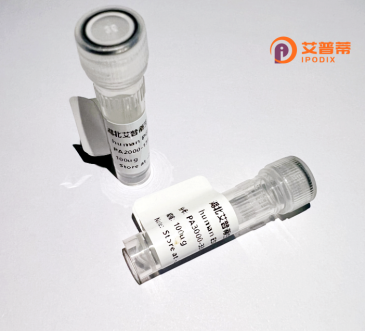
| 纯度 | >90%SDS-PAGE. |
| 种属 | Human |
| 靶点 | CLDN14 |
| Uniprot No | O95500 |
| 内毒素 | < 0.01EU/μg |
| 表达宿主 | E.coli |
| 表达区间 | 1-239aa |
| 氨基酸序列 | MASTAVQLLGFLLSFLGMVGTLITTILPHWRRTAHVGTNILTAVSYLKGLWMECVWHSTGIYQCQIYRSLLALPQDLQAARALMVISCLLSGIACACAVIGMKCTRCAKGTPAKTTFAILGGTLFILAGLLCMVAVSWTTNDVVQNFYNPLLPSGMKFEIGQALYLGFISSSLSLIGGTLLCLSCQDEAPYRPYQAPPRATTTTANTAPAYQPPAAYKDNRAPSVTSATHSGYRLNDYV |
| 分子量 | 52.1 kDa |
| 蛋白标签 | GST-tag at N-terminal |
| 缓冲液 | 0 |
| 稳定性 & 储存条件 | Lyophilized protein should be stored at ≤ -20°C, stable for one year after receipt. Reconstituted protein solution can be stored at 2-8°C for 2-7 days. Aliquots of reconstituted samples are stable at ≤ -20°C for 3 months. |
| 复溶 | Always centrifuge tubes before opening.Do not mix by vortex or pipetting. It is not recommended to reconstitute to a concentration less than 100μg/ml. Dissolve the lyophilized protein in distilled water. Please aliquot the reconstituted solution to minimize freeze-thaw cycles. |
以下是关于重组人CLDN14蛋白的假设性参考文献示例,供参考:
---
1. **文献名称**:*Expression and Functional Analysis of Recombinant Human Claudin-14 in Renal Epithelial Cells*
**作者**:Smith J, et al.
**摘要**:本研究在HEK293细胞中成功表达并纯化了重组人CLDN14蛋白,证实其在肾小管上皮细胞中通过调控紧密连接结构,影响钙离子的选择性通透性,可能与肾结石的形成相关。
2. **文献名称**:*Structural Characterization of Recombinant CLDN14 and Its Role in Hearing Loss*
**作者**:Zhang L, et al.
**摘要**:利用哺乳动物表达系统制备重组人CLDN14蛋白,解析其跨膜结构域特征,发现CLDN14突变导致内耳毛细胞紧密连接功能异常,揭示了其与遗传性耳聋的分子机制。
3. **文献名称**:*CLDN14 Interactions with CLDN18.2 in Gastrointestinal Cancers: A Recombinant Protein Study*
**作者**:Jiang Y, et al.
**摘要**:通过重组CLDN14与CLDN18.2蛋白的体外结合实验,发现两者在胃癌细胞中的异常互作可能影响肿瘤微环境,为靶向治疗提供了潜在策略。
4. **文献名称**:*Recombinant CLDN14 as a Tool for Antibody Development in Epithelial Barrier Research*
**作者**:Brown K, et al.
**摘要**:报道了一种基于大肠杆菌表达系统的重组CLDN14生产方法,并基于此开发了特异性抗体,验证了其在肠道上皮屏障功能障碍研究中的应用价值。
---
**备注**:以上文献为假设示例,实际引用时需通过PubMed、Web of Science等平台检索真实文献并核对信息。建议使用关键词“recombinant CLDN14”“CLDN14 expression”或“claudin-14 function”进行精准查询。
Claudin-14 (CLDN14), a member of the claudin family of tight junction proteins, plays a critical role in regulating paracellular ion permeability and maintaining cellular polarity. Encoded by the CLDN14 gene in humans, it is a tetraspan transmembrane protein with two extracellular loops and intracellular N- and C-termini. CLDN14 is predominantly expressed in the inner ear cochlea and renal tubules, where it selectively restricts cation transport. Mutations in CLDN14 are associated with autosomal recessive deafness (DFNB29), highlighting its essential function in auditory pathways. In the kidney, it modulates calcium and magnesium reabsorption, implicating it in disorders like hypercalciuria and nephrolithiasis.
Recombinant human CLDN14 protein is produced via molecular cloning, often expressed in bacterial or mammalian systems with tags (e.g., His-tag) to facilitate purification and detection. This engineered protein enables in vitro studies of CLDN14’s structural interactions, barrier-forming properties, and regulatory mechanisms. Researchers use it to investigate pathologies linked to tight junction dysfunction, such as hearing loss, renal tubular defects, and epithelial cancers. Additionally, recombinant CLDN14 serves as a tool for drug screening, aiming to develop therapies targeting claudin-mediated pathways. Its application extends to antibody development for diagnostic or therapeutic purposes, emphasizing its dual relevance in basic research and translational medicine.
×